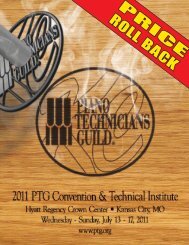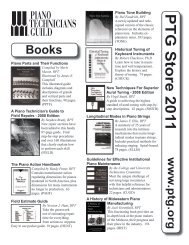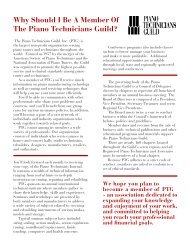Download PDF - Piano Technicians Guild
Download PDF - Piano Technicians Guild
Download PDF - Piano Technicians Guild
You also want an ePaper? Increase the reach of your titles
YUMPU automatically turns print PDFs into web optimized ePapers that Google loves.
Iron, Steel & <strong>Piano</strong>s<br />
Continued from Previous Page<br />
All steels and cast irons also contain other elements and<br />
materials. Some of these, such as sulphur and phosphorus,<br />
are residual impurities which generally have been reduced<br />
in manufacture to the economic minimum. Others, such as<br />
silicon and manganese, may be purposely left in in controlled<br />
amounts, or be purposely added, to give the material<br />
special qualities. Examples are gray cast iron, containing<br />
considerable silicon, and the many alloy steels containing<br />
chromium, nickel, molybdenum and so on.<br />
The steel category includes a large spectrum of materials,<br />
classified by carbon content, as well as by the percentage<br />
ranges of other alloying elements. Music wire is generally<br />
made from carbon steel, as distinguished from alloy steel,<br />
which means that no deliberate alloy additions are used.<br />
(Except manganese. Almost all steels, either carbon or alloy,<br />
contain appreciable amounts of manganese.)<br />
Apart from the chemical distinction between steel and<br />
cast iron, one of the most important differences is that the<br />
various steels are generally ductile and malleable in varying<br />
degrees, while cast iron generally is not. (The amenability of<br />
a material to plastic deformation under stress without<br />
fracture is called ductility or malleability, according as the<br />
stress is tensile or compressive.)<br />
Wire could not be made from cast iron because the<br />
manufacturing process and most wire usages demand a<br />
ductile material. On the other hand, piano plates could be<br />
made of steel by forging, casting or welding, but among<br />
other disadvantages they would be costly far beyond any<br />
strength superiority they would have over plates of gray cast<br />
iron.<br />
We will return to some of the other properties and<br />
reactions of these materials after a short excursion into iron<br />
and steel making.<br />
The manufacture of steel divides rather naturally into<br />
two stages:<br />
1) making the material and 2) making the product from<br />
the material (product meaning bars, structural shapes, sheets,<br />
wire, etc.). With gray cast iron on the other hand, the<br />
material is generally turned out in product form, as we shall<br />
see.<br />
Pig Iron — The Blast Furnace<br />
The first step for either steel or cast iron is to recover iron in<br />
usable form from iron ore, which is iron oxide (rust) in<br />
varying mixtures with earth, sand and rock. This recovery is<br />
mostly a process of getting rid of the oxygen by heating the<br />
ore in the presence of carbon and limestone. This takes place<br />
in a blast furnace, which is a shaft, typically 25 feet or more<br />
in diameter by 75 feet or more in height, charged with<br />
18 <strong>Piano</strong> <strong>Technicians</strong> Journal / November 2000<br />
layers of coke, ore and limestone, which form a descending<br />
column. Air is forced in at the bottom, and the coke burns<br />
partially to carbon monoxide, which in turn reduces the<br />
iron oxide ore. The limestone forms a molten, fluid slag,<br />
which, floating on the molten iron, accumulates and carries<br />
off much of the waste matter. The blast furnace operates<br />
continuously, with materials charged at the top and the slag<br />
and molten pig iron drawn off at the bottom. This is a hot<br />
process, with a temperature gradient in the furnace from a<br />
few hundred degrees at the top to about 2,750 degrees F. at<br />
the bottom.<br />
Pig iron, the blast furnace product, contains fairly large<br />
percentages (totaling seven percent or more) of impurities<br />
such as silicon, manganese, sulphur, phosphorus and an<br />
excess of carbon. “Impurities” is a relative term, as some of<br />
these inclusions are impurities only as they are in excess for<br />
the purpose at hand.<br />
Gray Cast Iron — The Cupola<br />
If the end product is to be gray cast iron, the pig iron from<br />
the blast furnace is refined in an oxidizing furnace known as<br />
a cupola. In foundry practice the cupola charge usually<br />
includes cast iron and steel scrap and ferro-silicon, as well as<br />
the pig iron. Coke for fuel and limestone for flux are also<br />
included. Because little or no chemical correction is possible<br />
in the cupola after melting, the charge must be carefully<br />
planned as to proportions of entering materials, based on<br />
the constitution of these materials and the desired constitution<br />
of the product. A typical melt for piano plates might<br />
contain 3.5 percent carbon and 2.4 percent silicon, about<br />
which more will be said later.<br />
The molten “cast iron” is drawn off and poured into<br />
molds, usually of sand, in which it takes the shapes of the<br />
patterns used in preparing the molds — piano plates, for<br />
example.<br />
Steel — Making the Material<br />
If the end material is to be steel, the pig iron from the blast<br />
furnace is refined in one of various types of oxidizing<br />
furnace permitting closer control than the cupola of the<br />
iron foundry. The reader will have heard of the Bessemer<br />
converter and the open-hearth furnace, both long used in<br />
steel making. The electric furnace, once limited to special<br />
steel manufacture, is now used extensively in the production<br />
of more common grades. Steel music wire may be made of<br />
either open hearth or electric furnace steel, never Bessemer.<br />
(The very fast Bessemer process is not deliberate enough to<br />
allow the analysis and chemical corrections necessary to the<br />
careful manufacture of high carbon steel.)












